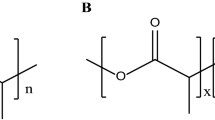Abstract
Purpose. The acidic microclimate in poly(D, L-lactide-co-glycolide) 50/50 microspheres has been previously demonstrated by our group as the primary instability source of encapsulated bovine serum albumin (BSA). The objectives of this study were to stabilize the encapsulated model protein, BSA, and to achieve continuous protein release by using a blend of: slowly degrading poly(D, L-lactide) (PLA), to reduce the production of acidic species during BSA release; and pore-forming poly(ethylene glycol) (PEG), to increase diffusion of BSA and polymer degradation products out of the polymer.
Methods. Microspheres were formulated from blends of PLA (Mw 145,000) and PEG (Mw 10,000 or 35,000) by using an anhydrous oil-in-oil emulsion and solvent extraction (O/O) method. The polymer blend composition and phase miscibility were examined by FT-IR and DSC, respectively. Microsphere surface morphology, water uptake, and BSA release kinetics were also investigated. The stability of BSA encapsulated in microspheres was examined by losses in protein solubility, SDS-PAGE, IEF, CD, and fluorescence spectroscopy.
Results. PEG was successfully incorporated in PLA microspheres and shown to possess partial miscibility with PLA. A protein loading level of 5% (w/w) was attained in PLA/PEG microspheres with a mean diameter of approximately 100 μm. When PEG content was less than 20% in the blend, incomplete release of BSA was observed with the formation of insoluble, and primarily non-covalent aggregates. When 20%-30% PEG was incorporated in the blend formulation, in vitro continuous protein release over 29 days was exhibited. Unreleased BSA in these formulations was water-soluble and structurally intact.
Conclusions. Stabilization and controlled relaease of BSA from PLA/PEG microspheres was achieved due to low acid and high water content in the blend formulation.
Similar content being viewed by others
REFERENCES
S. P. Schwendeman, H. R. Costantino, R. K. Gupta, and R. Langer. Peptide, Protein, and Vaccine Delivery from Implantable Polymeric Systems. In K. Park (ed.), Controlled Drug Delivery, Challenges and Strategies, American Chemical Society, Washington, DC, 1997 pp. 229-267.
G. Zhu, S. R. Mallery, and S. P. Schwendeman. Stabilization of proteins encapsulated in injectable poly(lactide-co-glycolide). Nat. Biotechnol. 18:52-57 (2000).
G. Zhu and S. P. Schwendeman. Stabilization of proteins encapsulated in cylindrical poly(lactide-co-glycolide) implants: Mechanism of stabilization by basic additives. Pharm. Res. 17:350-356 (2000).
E. P. Magre and A. P. Sam. Hydrolytic degradation of PLAGA, calculation of rate constants from various types of in vitro degradation curves. J. Control. Release 48:318-319 (1997).
A. Shenderova. The Microclimate in poly(lactide-co-glycolide) microspheres and its effect on the stability of encapsulated substances. Ph. D Thesis, The Ohio State University, Columbus, OH, 2000.
P. Giunchedi, B. Conti, S. Scalia, and U. Conte. In vitro degradation study of polyester microspheres by a new HPLC method for monomer release determination. J. Control. Release 56:53-62 (1998).
G. Crotts and T. G. Park. Stability and release of bovine serum albumin encapsulated within poly(D,L-lactide-co-glycolide) microparticles. J. Control. Release 44:123-134 (1997).
T. G. Park, S. Cohen, and R. Langer. Poly(L-lactic acid)/Pluronic blends: Characterization of phase separation behavior. degradation, and morphology and use as protein-releasing matrices. Macromolecules 25:116-122 (1992).
M.-K. Yeh, S. S. Davis, and A. G. A. Coombes. Improving protein delivery from microparticles using blends of poly(DL lactide-co-glycolide) and poly(ethylene oxide)-poly(propylene oxide) co-polymers. Pharm. Res. 13:1693-1698 (1996).
S. J. Peter, L. Lu, D. J. Kim, G. N. Stamatas, M. J. Miller, M. J. Yaszemski, and A. G. Mikos. Effects of transforming growth factor B1 released from biodegradable polymer microparticles on marrow stromal osteoblasts cultured on poly(propylene fumarate) substrates. J. Biomed. Mater. Res. 50:452-462 (2000).
R. L. Cleek, K. C. Ting, S. G. Eskin, and A. G. Mikos. Microparticles of poly(DL-lactic-co-glycolic acid)/poly(ethylene glycol) blends for controlled drug delivery. J. Control. Release 48:259-268 (1997).
E. C. Lavelle, M.-K. Yeh, A. G. A. Coombes, and S. S. Davis. The stability and immunogenicity of a protein antigen encapsulated in biodegradable microparticles based on blends of lactide polymers and polyethylene glycol. Vaccine 17:512-529 (1999).
S. P. Schwendeman, M. Cardamone, A. Klibanov, M. R. Brandon, and R. Langer. Stability of proteins and their delivery from biodegradable polymer microspheres. In S. Cohen and H. Bernstein (eds.), Microparticulate Systems for the Delivery of Proteins and Peptides, Marcel Dekker, Inc., New York, 1996 pp. 1-49.
W. Jiang and S. P. Schwendeman. Stabilization of a model formalinized protein antigen encapsulated in PLGA microspheres. J. Pharm. Sci. (in press).
J. F. Foster. Albumin Structure, Function and Uses, Pergamon, Oxford, 1977.
T. G. J. Peters. All about Albumin: Biochemistry, Genetics, and Medical Applications, Academic Press, San Diego, 1996.
W. Jiang and S. P. Schwendeman. Formaldehyde-mediated aggregation of protein antigens: Comparison of untreated and formalinized model antigens. Biotech. Bioeng. 70:507-517 (2000).
A. Shenderova, T. G. Burke, and S. P. Schwendeman. The acidic microclimate in poly(lactide-co-glycolide) microspheres stabilizes camptothecins. Pharm. Res. 16:241-246 (1999).
A. Shenderova, G. Zhu, and S. P. Schwendeman. Correlation of measured microclimate pH with the stability of BSA encapsulated in PLGA microspheres. Proceed. Int'l. Symp. Control. Rel. Bioact. Mater. 27:S0413 (2000).
G. Zhu. Stabilization and controlled release of proteins encapsulated in poly(lactide-co-glycolide) delivery systems. Ph D Thesis, The Ohio State University, Columbus, OH, 1999.
B. Farruggia, G. Garcia, C. D' Angelo, and G. Picó. Destabilization of human serum albumin by polyethylene glycols studied by thermodynamical equilibrium and kinetic approaches. Int'l J. Biol. Macromolecules 20:43-51 (1997).
Author information
Authors and Affiliations
Rights and permissions
About this article
Cite this article
Jiang, W., Schwendeman, S.P. Stabilization and Controlled Release of Bovine Serum Albumin Encapsulated in Poly(D, L-lactide) and Poly(ethylene glycol) Microsphere Blends. Pharm Res 18, 878–885 (2001). https://doi.org/10.1023/A:1011009117586
Issue Date:
DOI: https://doi.org/10.1023/A:1011009117586




